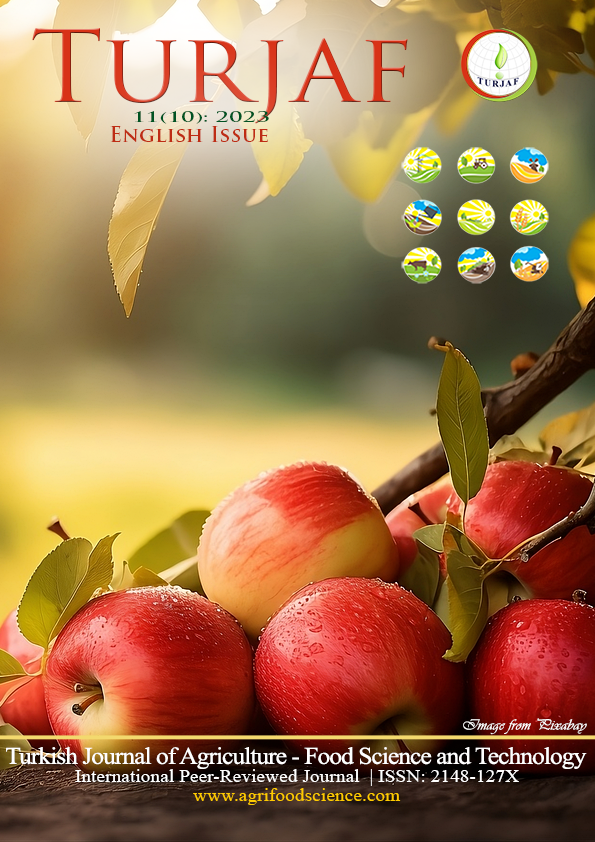Polygalacturonase Production by Sarocladium strictum T4 Isolate using Apricot Pulp as Substrate in Non-Sterile Culture Conditions
DOI:
https://doi.org/10.24925/turjaf.v11i10.1834-1838.6044Keywords:
Apricot pulp, Pectinase, Sarocladium strictum T4Abstract
In this study, 34 molds showing pectin degradation activity were isolated from the soil of orchards, by several tests. By using these isolates, pectinase group enzymes; studies on pectin lyase and polygalacturonase production were performed in the batch system and under non-sterile culture conditions. 5 isolates denoting polygalacturonase activity were coded as: T1, T2, T3, T4, T5 and the best polygalacturonase activity among these isolates was determined as 354.4 U/L in T4 isolate. Thus, optimization analyses continued by the use of this isolate. Initial apricot pulp concentration, temperature, pH and incubation period were tested as optimization parameters. The effects on enzyme activities were investigated by changing the initial apricot pulp concentration in the range of 5-100 (g/L), and in this regard, polygalacturonase activity was determined as 397.4 U/L at 50 g/L. In addition, the pH parameter was analyzed in each unit between pH = 3 – 8, and the temperature was tested by increasing 5 units in the range of 5-25°C. Consequently, the maximum polygalacturonase activity was determined as 405.7 U/L at pH 5 and 406.3 U/L at 15°C. Besides, the effect of the incubation period was studied within 1-5 days and the maximum polygalacturonase activity was determined as 429.0 U/L on the 4th day (after 96 hours). As a result, the above-mentioned T4 isolate, with which the optimization studies were conducted, was identified as Sarocladium strictum (Top ekinküfü) T4 by molecular methods.
References
Abbasi H, Fazaelipoor HM. 2010. Pectinase production in a defined medium using surface culture fermentation. Int. J. Ind. Chem., 1 (1), 5-10. ISSN : 2228-5547
Antranıkıan G, Vorgıas EC, Bertoldo C. 2005. Extreme Environments as a Resource for Microorganisms and Novel Biocatalysts. Adv Biochem Engin/Biotechnol, 96, 219–262. doi: 10.1007/b135786
Debinga J, Peijuna L, Stagnittib F, Xianzheb X, Lic L. 2005. Pectinase Production by Solid Fermentation from Aspergillus Niger by a New Prescription Experiment. Ecotoxicol Environ. Saf., 64 (2), 244-250. Doi: https://doi.org/10.1016/j.ecoenv.2005.01.002
Femenıa A, Sanchez ES, Sımal S, Rosello C. 1998. Development and Ripening-Related Effects on the Cell Wall of Apricot Fruit. J. Sci. Food Agr., 77, 487–493. Doi: https://doi.org/10.1002/(SICI)1097-0010(199808)77:4<487::AID-JSFA70>3.0.CO;2-T
Fogarty WM, Kelly CT. 1983. Pectic enzymes. In: Microbial enzymes and biotechnology. W.M. Fogarty (Ed.), Applied Science Publishers, London, England, 131-182. doi: 10.1007/978-94-009-0765-2
Güner A, Akata I, Akgül H, Akyüz E, et al., 2020. Türkçe Mantar Adları (Turkish Fungi Names). In: Sesli, E., Asan, A. & Selçuk, F. (eds.). Türkiye Mantarları Listesi (The Checklist of Fungi of Turkey). Ali Nihat Gökyiğit Vakfı Yayını. İstanbul.
Hoondal GS, Tiwari RP, Tewari R, Dahiya N, Beg QK. 2002. Microbial alkaline pectinases and their applications: A review. ISO4 Standard Appl. Microbiol. Biotechnol., 59, 409-418. Doi: https://doi.org/10.1007/s00253-002-1061-1
Jayani RS, Saxena S, Gupta R. 2005. Microbial pectinolytic enzymes: A review. Process Biochem., 40 (9), 2931-2944. Doi: https://doi.org/10.1016/j.procbio.2005.03.026
Morıta Y, Hasan Q, Sakaguch IT, Murakamı Y, Yokoyama K, Tamıya E. 1998. Properties of a cold-aktif protease from psychrophic Flavobacterium balustinum P104. Appl. Microbiol. Biotechnol., 50, 669-675. Doi: https://doi.org/10.1007/s002530051349
Nimnoi P, Lumyong S. 2011. Improving solid-state fermentation of Monascus purpureus on agricultural products for pigment production. Food Biopro Technol, 4:1384-1390. doi: 10.1007/s11947-009-0233-8
Patil SR, Dayanand A. 2006. Production of pectinase from deseeded sun Xower head by Aspergillus niger in submerged and solid-state conditions. Bioresour. Technol, 97, 2054–2058. Doi: https://doi.org/10.1016/j.biortech.2005.09.015
Roe B, Bruemmer JH. 1981. Changes in Pectic Substances and Enzymes During Ripening and Storage of ‘Keitt’ Mangos. J. Food Sci., 46, 186–189. Doi: https://doi.org/10.1111/j.1365-2621.1981.tb14560.x
Saad N, Briand M, Gardarin C, Briand Y, Michaud P. 2007. Production, purification and characterization of an endopolygalacturonase from Mucor rouxii NRRL 1894. Enzyme Microb. Technol., 41 (6-7), 800-805. Doi: https://doi.org/10.1016/j.enzmictec.2007.07.012
Saito K, Takakuwa N, Oda Y. 2004. Purification of the extracellular pectinolytic enzyme from the fungus Rhizopus oryzae NBRC 4707. Microbiol. Res., 159, 83-86. Doi: https://doi.org/10.1016/j.micres.2004.01.001
Sanchez S, Demain AL. 2011. Enzymes and Bioconversions of industrial. Pharmaceutical, and Biotechnological Significance, Org. Process Res. Dev., 15, 224-230. Doi: https://doi.org/10.1021/op100302x
Souza JVB, Silva ES, Maia MLS, Teixeira MFS. 2003. Screening of Fungal Strains for Pectinolytic Activity: Endopolygalacturonase Production by Peacilomyces clavisporus 2A.UMIDA.1., Process Biochem., 39, 455-458. Doi: https://doi.org/10.1016/S0032-9592(03)00092-X
Tepe Ö. 2012. Bacillus Pumilus (Nrrl B-212) ile Pektin ve Tarımsal Atıklardan Pektinaz Üretiminin İncelenmesi. Doktora Tezi, Fırat Üniversitesi, Fen Bilimleri Enstitüsü, Elazığ.
Uzuner S, Çekmecelioğlu D. 2016. Gıda atıklarının pektinaz enzimi üretiminde kullanımı. Gıda, Derleme, 41 (4), 259-266. doi: 10.15237/gida.GD15076
Velmurugan P, Hur H, Balachandar V, et al 2011. Monascus pigment production by solid-state fermentation with corn cob substrate. J Biosci Bioeng, 112:590-594. Doi: https://doi.org/10.1016/j.jbiosc.2011.08.009
Wang X, Chen Q, Lü, X. 2014. Pectin extracted from apple pomace and citrus peel by subcritical water. Food Hydrocoll, 38, 129–137. Doi: https://doi.org/10.1016/j. foodhyd.2013.12.003
Downloads
Published
How to Cite
Issue
Section
License
This work is licensed under a Creative Commons Attribution-NonCommercial 4.0 International License.









